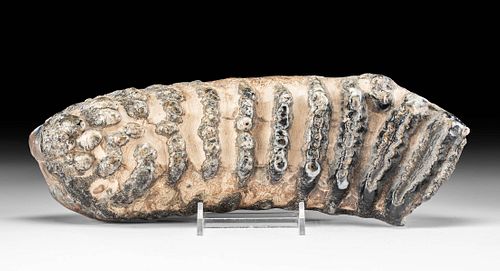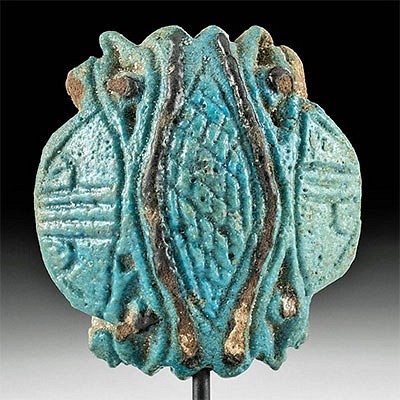Large Fossilized Woolly Mammoth Molar
Lot 133
About Seller
Artemis Fine Arts
686 S Taylor Ave, Ste 106
Louisville, CO 80027
United States
Selling antiquities, ancient and ethnographic art online since 1993, Artemis Gallery specializes in Classical Antiquities (Egyptian, Greek, Roman, Near Eastern), Asian, Pre-Columbian, African / Tribal / Oceanographic art. Our extensive inventory includes pottery, stone, metal, wood, glass and textil...Read more
Estimate:
$600 - $900
Absentee vs Live bid
Two ways to bid:
- Leave a max absentee bid and the platform will bid on your behalf up to your maximum bid during the live auction.
- Bid live during the auction and your bids will be submitted real-time to the auctioneer.
Bid Increments
| Price | Bid Increment |
|---|---|
| $0 | $25 |
| $300 | $50 |
| $1,000 | $100 |
| $2,000 | $250 |
| $5,000 | $500 |
| $10,000 | $1,000 |
| $20,000 | $2,500 |
| $50,000 | $5,000 |
| $100,000 | $10,000 |
| $200,000 | $20,000 |
About Auction
By Artemis Fine Arts
May 27, 2021
Set Reminder
2021-05-27 10:00:00
2021-05-27 10:00:00
America/New_York
Bidsquare
Bidsquare : CLEARANCE | Antiquities & Ethnographic Art
https://www.bidsquare.com/auctions/artemis-gallery/clearance-antiquities-ethnographic-art-7010
Featuring discounted pricing and many new items! Asian art, Classical antiquities from Egypt, Greece, Italy, and the Near East...plus Pre-Columbian, Tribal, Russian Icons & Enamelware, Spanish Colonial, Fine Art, more! Some starting prices have been reduced up to 65% from original auction prices! Artemis Fine Arts info@artemisfinearts.com
Featuring discounted pricing and many new items! Asian art, Classical antiquities from Egypt, Greece, Italy, and the Near East...plus Pre-Columbian, Tribal, Russian Icons & Enamelware, Spanish Colonial, Fine Art, more! Some starting prices have been reduced up to 65% from original auction prices! Artemis Fine Arts info@artemisfinearts.com
- Lot Description
**First Time At Auction**
New World, present day Alaska, or Central Asia, Siberia, Pleistocene (Ice Age), ca. 100,000 to 20,000 years old. A large, fossilized tooth from the prehistoric woolly mammoth! This tooth is a lengthy molar with prominent horizontal ridges for grinding up vegetation. The original chemicals of the tooth were replaced during the fossilization process with quartz (silica) and other minerals that have developed lovely hues of beige, white, blue-gray, and deep black. The rounded and smooth edges of the crowns are pleasingly tactile. The bones, teeth, and even fur of these massive herbivores have been preserved by the icy climate in which these mammoths once thrived and give us a fascinating glimpse of their existence. Size: 11.5" L x 3.5" W x 3" H (29.2 cm x 8.9 cm x 7.6 cm)
While mammoths survived until ca. 5600 years ago on remote Alaskan islands, those animals had begun to shrink in size as the climate warmed from the end of the Ice Age ca. 10,000 years ago. The name mammoth comes from a Siberian word used to describe the tusks found there by native people, like the Khanty of the Irtysh River basin, and traded to Europe and China. Their occasional finds of massive tusks and even preserved mammoth bodies in the permafrost - often eroding out of the sides of riverbanks - led to their folkloric belief that mammoths were like huge rodents, dwelling underground, dying when they accidentally surfaced. With the invention of science as a discipline, massive fossils like this one continued to capture imaginations all over the world. For example, Thomas Jefferson, who was fascinated by paleontology, is credited with introducing the use of the word mammoth as an adjective to describe something very large.
Provenance: ex-Stein collection, Bloomfield Hills, Michigan, USA, acquired prior to 2010
All items legal to buy/sell under U.S. Statute covering cultural patrimony Code 2600, CHAPTER 14, and are guaranteed to be as described or your money back.
A Certificate of Authenticity will accompany all winning bids.
We ship worldwide and handle all shipping in-house for your convenience.
#164329Stable fissures from fossilization process. Chips and losses to underside of tooth. Felt pads added to underside for stabilization.Condition
- Shipping Info
-
All shipping is handled in-house for your convenience. Your invoice from Artemis Gallery will include shipping calculation instructions. If in doubt, please inquire BEFORE bidding for estimated shipping costs for individual items.
-
- Buyer's Premium



 EUR
EUR CAD
CAD AUD
AUD GBP
GBP MXN
MXN HKD
HKD CNY
CNY MYR
MYR SEK
SEK SGD
SGD CHF
CHF THB
THB














